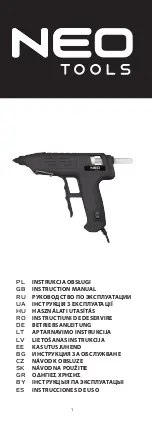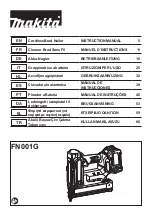
4
1. SAFETY INSTRUCTIONS
PRECAUTIONS ON USING THE TOOL
1.
WEAR SAFETY GLASSES OR GOGGLES
Danger to the eyes always exists due to the possibility of dust being blown up by the exhausted air
or of a fastener flying up due to the improper handling of the tool. For these reasons, safety glasses
or goggles shall always be worn when operating the tool.
The employer and/or user must ensure that proper eye protection is worn. Eye protection equipment
must conform to the requirements of the American National Standards Institute, ANSI Z87.1 (Council
Directive 89/686/EEC of 21 DEC. 1989) and provide both frontal and side protection.
The employer is responsible to enforce the use of eye protection equipment by the tool operator
and all other personnel in the work area.
NOTE:
Non-side shielded spectacles and face shields alone do not provide adequate protection.
2.
EAR PROTECTION MAY BE REQUIRED IN SOME ENVIRONMENTS
As the working condition may include exposure to high noise levels which can lead to hearing
damage, the employer and user should ensure that any necessary hearing protection is provided and
used by the operator and others in the work area.
3.
DO NOT USE ANY POWER SOURCE EXCEPT AN AIR COMPRESSOR
The tool is designed to operate on compressed air. Do not operate the tool on any other highpressure
gas, combustible gases (e.g., oxygen, acetylene, etc.) since there is the danger of an explosion. For
this reason, absolutely do not use anything other than an air compressor to operate the tool.
4.
OPERATE WITHIN THE PROPER AIR PRESSURE RANGE
The tool is designed to operate within an air pressure range of 70 to 100 p.s.i. (5 to 7 bar).
The pressure should be adjusted to the type of the work being fastened. The tool shall never be
operated when the operating pressure exceeds 120 p.s.i. (8 bar).
Never connect the tool to air pressure which potentially exceeds 200 p.s.i. (14 bar) as the tool can
burst.
5.
DO NOT OPERATE THE TOOL NEAR A FLAMMABLE SUBSTANCE
Never operate the tool near a flammable substance (e.g., thinner, gasoline, etc.). Volatile fumes from
these substances could be drawn into the compressor and compressed together with the air and this
could result in an explosion.
6.
DO NOT USE A WRONG FITTINGS
The connector on the tool must not hold pressure when air supply is disconnected. If a wrong fitting
is used, the tool can remain charged with air after disconnecting and thus will be able to drive a
fastener even after the air line is disconnected, possibly causing injury.
7.
DISCONNECT THE AIR SUPPLY AND EMPTY THE MAGAZINE WHEN THE TOOL IS NOT
IN USE
Always disconnect the air supply from the tool and empty the magazine when operation has been
completed or suspended, when unattended, moving to a different work area, adjusting,
disassembling, or repairing the tool, and when clearing a jammed fastener.
WARNING:
TO AVOID SEVERE PERSONAL INJURY OR PROPERTY DAMAGE
BEFORE USING THE TOOL, READ CAREFULLY AND UNDERSTAND THE FOLLOWING
“SAFETY INSTRUCTIONS”. FAILURE TO FOLLOW WARNINGS COULD RESULT IN DEATH OR
SERIOUS INJURY.
5
7
70
100




































